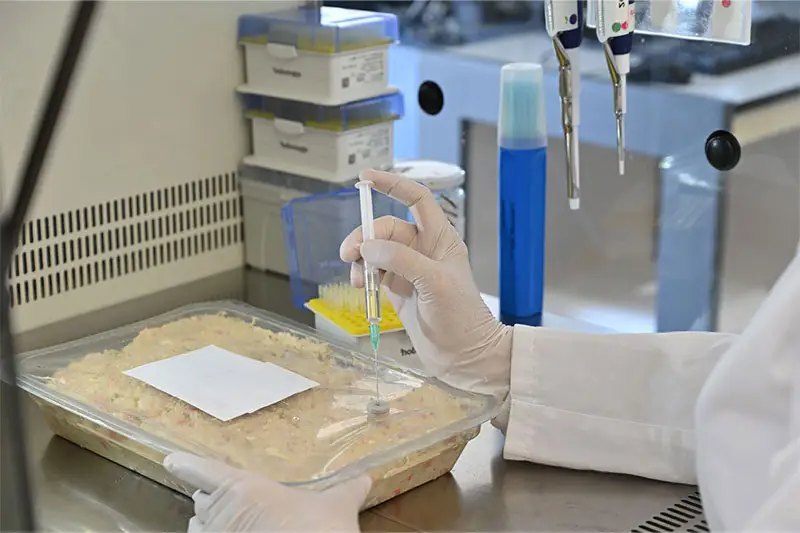Swab Testing for Microbial Contamination in Cosmetic Lines
The swab testing process is a critical component of microbiological safety testing in cosmetics. This method involves collecting samples from various parts of cosmetic products using sterile swabs, followed by laboratory analysis to ensure the absence or presence of harmful microorganisms as per international standards.
Microbial contamination can lead to severe health issues including skin irritations, infections, and allergic reactions. Therefore, rigorous testing is essential before any product reaches the market. The Cosmetics Directive (EC 1223/2009) emphasizes the importance of microbiological safety in cosmetic products, requiring manufacturers to ensure their products are free from pathogenic microorganisms.
Swab testing typically involves collecting samples with a sterile swab moistened with an appropriate buffer solution. The swabs are then streaked onto selective media plates and incubated under controlled conditions to allow for the growth of any potential contaminants. The resulting colonies can be identified using biochemical tests, mass spectrometry, or other identification techniques.
For liquid cosmetics like shampoos and lotions, a loop technique is often used where 1 mL of the sample is transferred to 9 mL of buffered peptone water (BPW) for dilution. For solid products such as creams and powders, swabs are rubbed over specific areas according to the product's surface area.
The choice of media plates is crucial; they should be selective enough to inhibit non-targeted microorganisms while allowing target organisms like Staphylococcus aureus, Pseudomonas aeruginosa, and other common contaminants to grow. Commonly used media include thymol blue agar, mannitol salt agar, and chromogenic media.
Laboratories must adhere strictly to ISO 16170:2020 guidelines for microbiological examination of cosmetics to ensure the accuracy and reliability of results. This includes precise specimen preparation, accurate reporting, and compliance with standard operating procedures (SOPs).
Why Choose This Test
The swab testing process is essential in ensuring the safety and efficacy of cosmetic products. By detecting microbial contamination early in the development or production stage, manufacturers can take corrective actions to prevent potential recalls or health risks associated with contaminated products.
- Regulatory Compliance: Swab testing ensures compliance with international standards such as ISO 16170:2020 and EU Cosmetics Directive (EC 1223/2009).
- Risk Management: Early detection of microbial contamination allows for timely intervention to mitigate risks.
- Product Integrity: Ensures that products meet the required quality standards, protecting brand reputation and customer trust.
The test is particularly valuable in ensuring that all cosmetic lines are free from harmful microorganisms. This includes not only finished products but also raw materials and intermediate stages of production to catch contamination at its source.
By incorporating swab testing as part of their quality assurance protocols, manufacturers can demonstrate a commitment to safety and compliance with international standards. This enhances the credibility of the company and builds consumer confidence in the product's safety.
Quality and Reliability Assurance
- Method Validation: The swab testing method is validated according to ISO 16170:2020, ensuring that it consistently produces reliable results across different batches of samples.
- Standard Operating Procedures (SOPs): Strict adherence to SOPs ensures consistency and accuracy in specimen preparation and analysis.
- Laboratory Accreditation: Our laboratory is accredited by ISO/IEC 17025, ensuring that the testing process meets international standards for competence and impartiality.
The reliability of swab testing results can be enhanced through regular calibration of instruments used in the process. This includes checking pH meters, incubators, and spectrophotometers to ensure they are functioning within acceptable tolerances.
Additionally, cross-training laboratory personnel in various aspects of microbiological safety ensures that there is no single point of failure. Regular audits by independent bodies further reinforce the quality and reliability of the testing process.
International Acceptance and Recognition
- ISO/IEC 17025 Accreditation: Our laboratory is accredited to perform microbiological testing according to ISO/IEC 17025, ensuring international recognition.
- CNAS and APLAC: We are also accredited by CNAS (China National Accreditation Service for Conformity Assessment) and APLAC (Asian Laboratory Accreditation Cooperation), making us a trusted partner for global clients.
- FDA Compliance: Our testing methods comply with FDA standards, ensuring that our results meet the regulatory requirements of the United States.
The international acceptance and recognition of our swab testing services are further enhanced by our adherence to European Union (EU) Cosmetics Directive and other relevant regulations. This global reach allows us to serve a diverse client base across different regions, ensuring that all products meet the highest standards of safety and quality.





